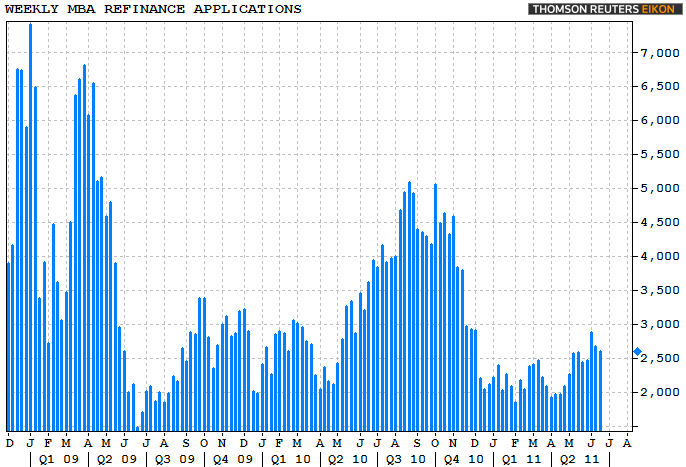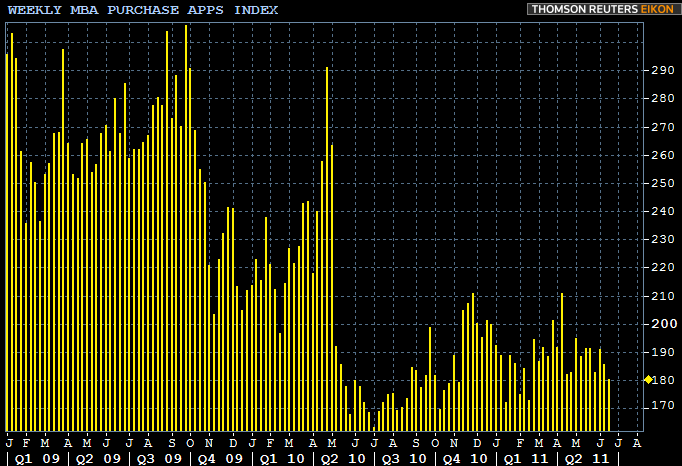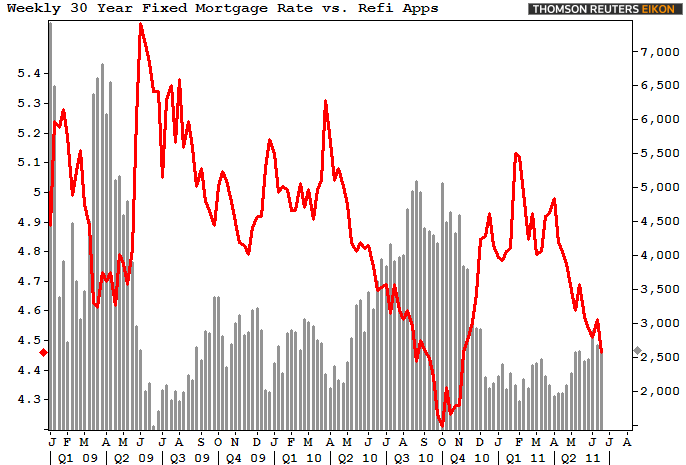Blog

Same Old Story. Low Rates Fail to Spark Loan Demand
The Mortgage Bankers Association (MBA) today released its Weekly MortgagernApplications Survey* for the week ending June 24, 2011.</p
After seeing a modest uptick in refinance applications three weeks ago after mortgage rates set new year-to-date lows, momentum has once again stalled. The Refinance Index declined 7.2 percent two weeks ago and another 2.6 percent in the most recent report. Purchase demand decreased too, this time by 3.0%. Although mortgage rates have rallied back to levels just above their all-time lows, home loan demand has largely failed to react to it.</p
Excerpts from the Release…</p
The Market Composite Index, a measure of mortgage loan application volume,rndecreased 2.7 percent on a seasonally adjusted basis from one weekrnearlier. On an unadjusted basis, the Index decreased 3.0 percent comparedrnwith the previous week. The four week moving average is up 0.7 percent.</p
The Refinance Index decreased 2.6 percent from the previous week. The fourrnweek moving average is up 1.5 percent. The refinance share of mortgage activityrnincreased to 69.5 percent of total applications from 69.2 percent the previousrnweek.</p
 </p
</p
The seasonally adjusted Purchase Index decreased 3.0 percent from one weekrnearlier. The unadjusted Purchase Index decreased 3.8 percent compared with thernprevious week and was 4.5 percent higher than the same week one year ago. Thernfour week moving average is down 1.5 percent.</p
 </p
</p
The average contract interest rate for 30-year fixed-rate mortgages decreasedrnto 4.46 percent from 4.57 percent, with points increasing to 1.19 from 0.91rn(including the origination fee) for 80 percent loan-to-value (LTV) ratiornloans. This is the lowest 30-year rate recorded in the survey since thernmiddle of November 2010. The effectivernrate also increased from last week. </p
The average contract interest rate for 15-year fixed-rate mortgages decreasedrnto 3.64 from 3.70 percent, with points increasing to 1.11 from 1.05(includingrnthe origination fee) for 80 percent LTV loans. This is the lowest 15-year rate recorded inrnthe survey since the beginning of Novemeber 2010. The effective rate also increased from lastrnweek. </p
The adjustable-rate mortgage (ARM) share of activity decreased to 5.8rnpercent from 5.9 percent of total applications from the previous week.</p
 </p
</p
We’re turning into a broken record on this but here goes anyway.Regarding the barriers that continue to block borrowers from reducing their monthly payments… </p
Over a month ago we wrote, “Right now we’re witnessing the beginnings of a mini-refinance boom in the primary mortgage market, but there has been little activity in the secondary market that would indicate increased rate locking by consumers.” says MND’s Managing Editor Adam Quinones. “However, if conventional 30-year rates reach 4.25%, we’d expect to see a mini-boom scenario play out. There is much stored demand in the system as many borrowers missed the boat on record low rates in October and early November. This crowd is waiting in the wings for those rates to return. Whether or not that happens is still very much up in the air” </p
In reaction to that comment, Ted Rood,rn a loan originator from MetLife Home Loans added, “One thing to considerrn regarding refi volume is that HUD effectively ended FHA streamlines over the course of the last year by tightening underwriting guidelines and jacking up monthly MIP fees. After the change, many existing FHA clients have been unable to meet net benefit rules, even when dropping their rate by 1% or more, since their monthly MIP would double on the new loan. So FHA clients don’t get to benefit from lower rates and HUD doesn’t get new upfront MIPs from existing clients with clean payment histories who want to refinance”.</p
READ MORE: New FHA MIP Structure to Slow Streamlines</p
READ MORE: Rents Seen Rising as Poor Credit Hurts Homeownership Demand</p
READ MORE: Realtors Request Looser Credit Regs as Home Sales Decline</p
* ABOUT: The MBA’srnloan application survey covers over 50% of all U.S. residential mortgage loanrnapplications taken by mortgage bankers, commercial banks, and thrifts. The datarngives economists a snapshot view of consumer demand for mortgage loans. In arnfalling mortgage rate environment, a trend of increasing refinance applicationsrnimplies consumers are seeking out lower monthly payments. If consumers are ablernto reduce their monthly mortgage payment and increase disposable income throughrnrefinancing, it can be a positive for the economy as a whole (may boostrnconsumer spending. It also allows debtors to pay down personal liabilitiesrnfaster. A trend of declining purchase applications implies home buyer demand isrnshrinking.
All Content Copyright © 2003 – 2009 Brown House Media, Inc. All Rights Reserved.nReproduction in any form without permission of MortgageNewsDaily.com is prohibited.
Latest Articles
By John Gittelsohn August 24, 2020, 4:00 AM PDT Some of the largest real estate investors are walking away from Read More...
Late-Stage Delinquencies are SurgingAug 21 2020, 11:59AM Like the report from Black Knight earlier today, the second quarter National Delinquency Survey from the Read More...
Published by the Federal Reserve Bank of San FranciscoIt was recently published by the Federal Reserve Bank of San Francisco, which is about as official as you can Read More...

Comments
Leave a Comment